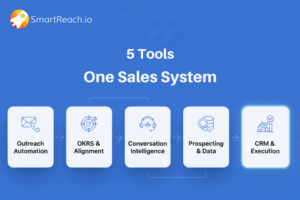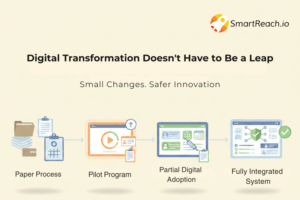Innovative Small Business Marketing Ideas to Boost Your Growth
Embracing innovative small business marketing ideas can be the key to unlocking new opportunities and driving substantial growth. In today’s competitive market, small businesses need more than just traditional methods to stand out and grow.
Whether you’re a startup or an established small business looking to refresh your strategy, this blog dives into the latest small business marketing techniques. Learn how to boost your brand’s visibility, engage your audience, and accelerate business growth.
Get ready to change your marketing approach with creative, effective ideas that deliver real results.
Importance and types of small business marketing
Small business marketing involves using all available resources to share, promote, and build awareness around your brand.
The goal is to increase your customer base and drive sales, but achieving this can be complex, as marketing can quickly become expensive and time-consuming.
Understanding how marketing works and identifying the best options for your business is crucial.
In today’s digital age, marketing is essential for success, regardless of business size.
Relying solely on word of mouth or occasional magazine ads is no longer sufficient.
Effective small business marketing requires leveraging multiple platforms and avenues including HRMS for small business to stay visible to customers.
This approach is vital for sharing your message with potential customers who might not yet know about your business, capturing new interests, and generating leads.
Additionally, it helps establish your brand’s presence and authority. Taking advantage of the power of various platforms is crucial for effective small business marketing. Blogs, websites, and digital channels all contribute to visibility and client engagement.
You can easily solidify your brand’s visual appeal with a compelling logo which you can craft by utilizing free online AI logo generator sites. You can also benefit from using a reliable file uploading service to easily manage, store, and share important marketing assets across platforms.
For businesses in specialized niches, integrating advanced machinery like a shrink sleeve machine can dramatically enhance product presentation and brand appeal. These machines streamline the application of custom labels, ensuring a professional look that captures consumer interest.
For instance, it’s crucial to incorporate diverse gym marketing ideas to attract and retain clients. This can include leveraging social media platforms to share workout tips, offering virtual classes, creating referral programs to encourage word-of-mouth promotion, and hosting community events to increase visibility and engagement. Such a comprehensive plan ensures that the marketing efforts are well-rounded and effectively target various customer segments. Incorporating key personal trainer app features like workout tracking, customized fitness plans, and direct messaging can further enhance client engagement and retention. Similarly, a tailored web design for family lawyer practices can ensure user-friendly navigation and highlight crucial services, helping potential clients easily connect and engage with legal professionals.
Examining professional web design for family lawyer practices can significantly boost client trust and improve online visibility.
By creating and sharing valuable content across various channels, small businesses can reach new audiences, engage in real-time interactions, offer helpful information, and gain insights into successful future strategies.
The types of small business marketing include
- Websites
- social media
- Blogs
- print.
Conducting thorough research on these options and making strategic choices tailored to your business can lead to the best outcomes. Selecting an appropriate research title for each marketing type will help focus your efforts and ensure that your strategies are effective and aligned with your business goals.
Small business marketing strategies
Let’s look into the strategies:
Know your audience
One common mistake is believing that “anyone” can be your customer. While large companies might cater to a broad audience, small businesses benefit from targeting a specific niche.
To do this effectively, understand your niche’s pain points, problems, and priorities. What motivates their purchases? What does success look like for them? Answering these questions will help you create compelling messaging.
SMB Marketing Consultant Tabitha Naylor says: “Developing a customer persona helps frame your marketing messages for a specific audience.
It ensures you’re addressing your ideal customer’s needs and preferred channels for content consumption.” Start by considering your current customers and the clients you want to attract. Then, develop a buyer persona to understand your ideal customer’s mindset.
Have a clear value proposition
If you can’t distinguish yourself from the competition, buyers have no reason to choose your business.
Your value proposition sets you apart and persuades prospects to select your services. Identify what you excel at better than anyone else in the industry and communicate this clearly to make a strong, convincing case for your business.
Focus on your goals and objectives
If you’re diving into marketing, you might find countless paths to follow. It’s tempting to try everything at once, hoping to cover all your bases. Marketing mix modeling can help identify which marketing channels contribute the most to revenue, allowing businesses to make data-driven decisions on resource allocation and campaign optimization.
However, this approach often leads to overwhelm. From my experience, it’s crucial to pinpoint where you can make the most significant impact. Identify the biggest blind spot in your marketing that’s hindering your growth.
Set a performance goal for that specific area and concentrate all your resources on the strategies and actions that will help you achieve that goal. Once you’ve made progress, you can then expand or shift focus to other initiatives. You can also use effective resource allocation software to manage and prioritize resources to ensure you’re targeting the right areas for growth.
Aim for short-term goals
Start small and scrappy. Achieving ROI quickly is crucial as you scale, providing the momentum and cash flow needed for larger projects and sustainable growth.
Tactics that require time to build, like SEO, aren’t ideal for initial efforts because they take longer to show returns. If you have the resources for long-term investments, that’s great, but don’t rely solely on them. Focus on short-term strategies that can deliver quick results.
For example, if you know people are searching for your solution on Google with purchasing intent, paid ads could offer a fast ROI.
Know what works and double your effort
Once you’ve tested various options and launched several initiatives, closely monitor the data. Data often reveals what works and what doesn’t, providing invaluable insights. Use these insights to prioritize and scale proven revenue-generating methods as you grow.
Build on your existing customers
Acquiring a new customer typically costs five times more than upselling to an existing one. It’s crucial not to overlook marketing efforts once a sale is made.
Instead, seize opportunities for repeat purchases, upselling, and cross-selling. Existing customers already trust your brand, so maintaining a positive experience encourages further business.
Even in cases where upselling isn’t feasible, continuing to provide excellent service is vital. After all, word of mouth remains a potent and cost-effective marketing tool.
Make your website
Having a professional website is paramount for any small business.
It serves as your digital storefront, showcasing your identity, offerings, location, and contact details. Consider working with a professional digital marketing agency that can also assist with your web design. Unlike social media platforms, you have complete ownership and control over your website. It acts as a perpetual marketing channel, capable of attracting both paid and organic traffic.
Your website isn’t merely a static brochure; with effective conversion strategies, it can function as a 24/7 sales engine. To maximize engagement and conversion rates, consider implementing the best push notifications – they will reengage visitors and also drive them to take action, whether it’s completing a purchase, signing up for a newsletter, or simply returning to explore more of what you offer.
Blog as much as you can to attract customers
Blogging presents an effective avenue for attracting organic traffic, especially from prospects still in the decision-making phase. Moreover, it aids in establishing credibility and positioning your brand as a thought leader within your industry.
Getting started is easy; utilize affordable or free website tools and templates to create a simple blog site. Incorporate compelling calls-to-action (CTAs) within your posts to encourage visitor engagement, such as subscribing to your blog or receiving emails.
Even with a weekly publishing schedule, your blog can significantly enhance your online visibility and educate potential customers on your company’s value proposition.
Promote on social media
Given the vast user base across numerous platforms, social media emerges as a potent business tool. Through social media marketing, businesses can effectively engage with potential customers, foster brand awareness, and showcase their products. Using TikTok trends and flyer maker to enhance promotional efforts. If you’re looking for creative digital signage options that work well with social content strategies, check this solution for displaying dynamic menus and promotions in real time.
After all, it’s essential to establish a presence where potential customers are actively spending their time.
Collaborate with influencers
Engaging in influencer marketing campaigns stands as one of the prominent trends in marketing today. Partnering with influencers within your niche guarantees exposure to your target audience.
These influencers possess a deep understanding of your niche and excel in storytelling, making them adept at conveying your brand’s narrative and selling your products to the right audience—potentially even more effectively than you could on your own.
Create shorts
From my experience, I’ve realized that an effective small business marketing strategy extends beyond written content. In 2022, 44% of social media marketers prioritized creating video content for TikTok.
Whether you opt for TikTok or other short-form video platforms such as YouTube, Instagram, or Facebook, incorporating short-form video content into your marketing mix is crucial. Boost your TikTok presence & buy a TikTok account to foster better connections and engagement with your audience.
These videos are concise and easily shareable, enabling you to swiftly introduce your product or service to the right audience—and their networks.
Invest in ads
Generating organic traffic takes time, making short-term pay-to-play tactics targeting high-intent buyers an effective way to kickstart other objectives.
This might explain why 80% of brands employ some form of paid advertising. If your target audience actively searches the web for your product or solution, Google Ads could be a suitable choice. If your target audience actively searches the web for your product or solution, Google Ads could be a suitable choice, especially if you connect Salesforce to Google Ads to streamline your campaign management and track conversions more effectively.
Alternatively, if they’re not actively searching, social media ads may be more effective. While social media users typically have lower buying intent, strategically targeted ads with sufficient impressions can capture their interest effectively.
Capture web prospects info
Up to this point, our focus has been on increasing visibility and traffic. But how does this translate into revenue? One effective method is to integrate a conversion tool into your website.
Look for a straightforward option that allows you to add a pop-up widget to collect email addresses from potential customers.
With these contacts, you can then send out promotions and offers, ultimately converting leads into paying customers. Additionally, you can explore various other conversion tools to further optimize your website and boost lead generation.
Use email outreach
Cold email marketing can be a powerful tool, but it needs to be done right.
One of such solution providers is SmartReach.io. It takes the guesswork out of cold email outreach. Our software lets you craft targeted messages that resonate with your ideal customer, using AI-powered content generator. .
Plus, SmartReach.io automates repetitive tasks like sending emails and managing bounces, freeing up your time. Track key metrics and integrate with your CRM for a unified view of your sales pipeline.
SmartReach.io helps you turn cold outreach into warm leads, ready to convert into paying customers!
Connect with local businesses
An effective strategy for small businesses to grow is by forming connections with fellow local business owners in the community.
Collaborating with them to offer joint discounts, deals, or coupons can be mutually beneficial. To make these promotions more accessible and engaging, consider using QR codes. Choosing the best QR code generator can help you create effective codes for sharing deals or event details, enhancing the customer experience.
Consider hosting livestream events or coordinating giveaways together, amplifying the reach by promoting them on both businesses’ social media platforms.
Small businesses marketing tools
Cold email outreach can significantly benefit small businesses in various ways.
It offers scalability, allowing businesses to reach a large number of prospects efficiently.
SmartReach.io facilitates effective lead nurturing by providing personalized and targeted communication, nurturing leads through the sales funnel. This leads to a faster sales cycle, as prospects are guided towards making purchasing decisions more quickly.
Additionally, cold email outreach ensures that no opportunities are missed with features like Shared Inbox, as businesses can consistently follow up with prospects and stay top-of-mind.
Moreover, adopting a collaborative approach by involving sales and marketing teams can optimize outreach efforts and improve results.
Furthermore, leveraging AI-powered content generation tools can enhance the quality and relevance of email content, increasing engagement rates. To build interest and increase engagement rates, it is crucial to create email content that is unique and free of errors. By checking AI-generated content with an AI detector tool, you can build trust and create more opportunities for quality content. This way, you can easily promote your small business without concerns about plagiarism or AI similarities.
Actionable reports and analytics provide valuable insights into campaign performance, enabling small businesses to refine their strategies and optimize future outreach efforts.
Integrating cold email outreach with CRM systems allows for seamless data management and improved lead tracking.
Lastly, automated workflows streamline the outreach process, saving time and resources while ensuring consistency and efficiency across campaigns.
Overall, cold email outreach presents a versatile and powerful tool for small businesses to expand their reach, nurture leads, and drive growth effectively.
You can make use of social media tools. SmartReach.io offers you full LinkedIn automation options loaded with features.
All scheduled tasks are seamlessly tracked, ensuring maximum efficiency in outreach campaigns. You can also tailor connection requests to your target audience.
After setting up the automated LinkedIn campaigns, simply find prospects using a prospect finder tool like ProspectDaddy, upload the CSV file, and switch your campaign to auto-pilot mode. This approach saves your representatives valuable time.
In case you are looking for only LinkedIn as a channel and do not want to pay for other channels then reach out to our support team and we might just be able to cater to your demand.
If your business needs to make cold calls SmartReach.io can be a viable options of your business.
Utilizing SmartReach’s PowerCaller, sales representatives can efficiently handle their daily cold calls, ensuring a focused and productive approach.
Campaign Call Scripts empower reps to stay on message and deliver consistent, effective sales pitches.
Call Forward allows calls to be redirected to your mobile device, ensuring you never miss important callbacks while on the go.
The Listen, Barge-in, and Whisper functionality enables supervisors to provide real-time coaching during live calls, addressing concerns and closing deals more effectively.
Additionally, the Call Task Manager streamlines calling tasks with timely reminders and flexible scheduling.
You can talk to our experts for customized pricing.
Conclusion
Small business marketing is a tricky and interesting game. While you have the potential to run your business keeping the above mentioned strategies in place, you can think of growth avenues too.
What’s needed is to spot your business goals and find a way to work towards those without compromising on the basic business approach-grow while lowering costs.
This guide is an attempt to guard you against the pitfalls and keep you on track of what most businesses miss during the initial years.
Implementing what was mentioned above will mean you have the opportunity to run your business healthy while you have the power to grow year-on-year.
FAQs
What is the best marketing for small businesses?
The most effective marketing strategies for small businesses are those that successfully reach a significant portion of their target audience. This approach can vary based on several factors: the nature of your product or service, your sales methods, the demographics of your intended audience, and the specific buyer’s journey they undergo.
What are the top marketing mistakes small businesses make?
One of the biggest marketing mistakes small businesses make is persisting with ineffective methods. By closely monitoring your analytics, you can identify the most effective marketing strategies for your current needs and make necessary adjustments for future success.
What’s the cheapest way to promote your business?
The most affordable way to promote your business is to employ a variety of low-cost strategies at the same time. If you’re just starting out, focus on one or two social media platforms, build an email list, publish a blog on your website, and use one of the free SEO tools available.
How is marketing different from sales?
Marketing focuses on building brand awareness and making your company stand out among competitors. In contrast, sales aim to close deals and convert the interested prospects generated by the marketing team into paying customers.
About SmartReach.io
SmartReach.io is a leading multi-channel sales engagement platform for sales outreach sequences via email, Linkedin, calls, text, and WhatsApp.




